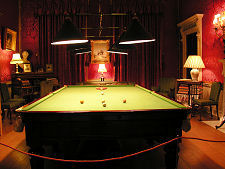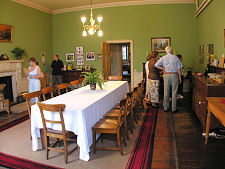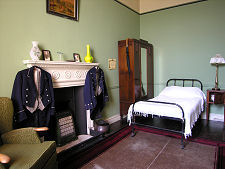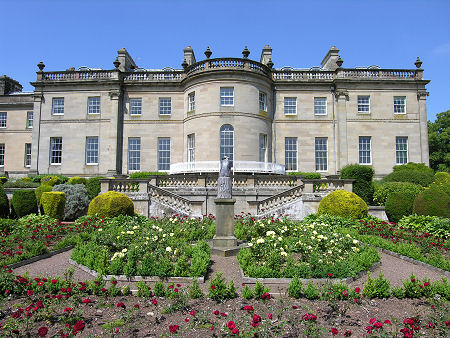 Manderston's South Frontage |
The Edwardian era lasted a mere decade, yet is one of the most fascinating periods in history. It is remembered as a "Golden Age" that stands out distinctly from the Victorian era that preceded it and, still more strikingly, from the horrors of the First World War and the loss of nearly an entire male generation that so soon followed its end.
In Scotland the purest expression of the Edwardian era can be found at Manderston, a remarkable country house two miles east of Duns. Here you find a house that was extensively rebuilt and remodelled between 1901 and 1905 on an unlimited budget: and what emerged was the very best available at the time. Just as importantly, the house has since been maintained and managed in a way that preserves the spirit of a brief carefree age that was so quickly lost.
Manderston's role as the epitome of an Edwardian country house was confirmed and widely publicised by the Channel 4 TV series The Edwardian Country House (broadcast in the USA as Manor House by PBS.) This six part series broadcast in 2002 cast a modern family of five in the role of their Edwardian predecessors, supported by a group of volunteers in the roles of 14 household servants.
For three months, Manderston functioned as it would have done in the years after 1905, with the addition of TV cameras ever ready to capture the action. Every participant in the production agreed to live with Edwardian technology and to abide by Edwardian standards of behaviour. The result was remarkable and enthralling television and an unsurpassed insight into the era.
Today's Manderston does not have a cast of residents or servants on view, living out lives from a century earlier. But the most important participant in the TV series, the house itself, remains resplendent in its Edwardian glory. As a result visitors are able to glimpse aspects of the lives of those who lived "above stairs" in the early 1900s, and in many ways gain a rather deeper understanding of the 20 or more servants who would have lived "below stairs" to ensure that the house functioned at it should. A visit to Manderston is a remarkable experience.
Manderston started out as a square shaped mansion built in about 1790 for Mr Dalhousie Weatherstone. In 1855 the house and estate were purchased by Richard Miller, and on his death it was purchased by his brother, William Miller. William was a self-made man, building a fortune trading hemp and herrings with the Russians before becoming British Consul in St Petersburg for 16 years.
On his return to Scotland, William Miller became MP for Leith, and later for Berwickshire. He was made a Baronet in 1874 for his political services to the then Prime Minister William Gladstone: despite, it is thought, his never actually having made a speech in the House of Commons.
In 1871 Sir William Miller, as he was to become, extended the 1790 house, adding a pillared entrance porch and a range of servants' quarters. On Sir William's death, Manderston passed to his younger son, Sir James Miller, who inherited because his older brother had died some years previously.
In 1890 Sir James married the Hon. Eveline Curzon, daughter of Lord Scarsdale. He then set to work to bring Manderston up to something more like the standard his new wife had been used to at her family home of Kedleston Hall in Derbyshire. His first step was to engage the architect John Kinross to improve the terraces to the south of the house and build the boathouse.
In 1895 he turned to Kinross again, this time to build the magnificent stable block to the north of the main house, some cottages and a nearby farm.
Sir James then spent time in the army, fighting in the Boer War, and on his return to Manderston in 1901 asked John Kinross to completely remodel the house itself. He wanted something that would allow him to entertain the great and good of Borders society, and something large enough to accommodate the large number of servants needed to live in the Edwardian manner. When Kinross asked about costs, Sir James replied that it "simply didn't matter".
The house that emerged in 1905 had a completely new north front and a very different roofline to its predecessor. And the opulent nature of the project was reflected in the installation of the world's only silver staircase. Meanwhile what had previously been a stable block on the west side of the house was converted to house servants and service areas.
On 7 November 1905 Sir James and Lady Miller gave a ball at Manderston to celebrate the completion of the house. Sadly Sir James died less than three months later, of pneumonia brought on by hunting on a cold January day. After his death the estate passed to a nephew, grandfather of the current laird of Manderston on his mother's side. The current laird's title of the 4th Lord Palmer of Reading comes from his father's side.
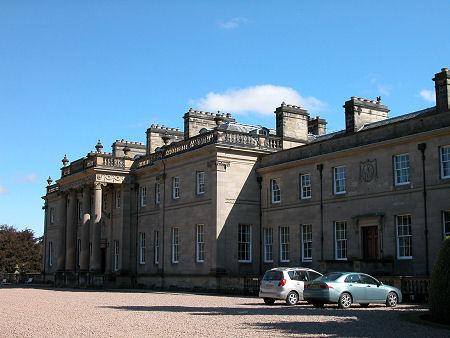 The North Side of Manderston |

|
|
|
Visitor InformationView Location on MapDuns, TD11 3PP. Tel: 01361 883450. enquiries@manderston.co.uk Grid Ref: NT 811 544 www.manderston.co.uk Opening Hours Admission Accessibility What3Words Location: ///debut.eating.exacts |
 Dining Room |
 The Hall |
 Ballroom |
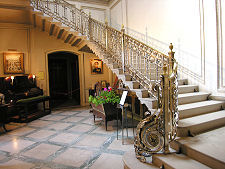 The Silver Staircase |
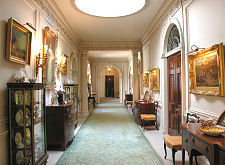 Upper Corridor |
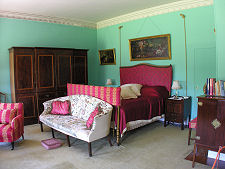 The North Bedroom |


